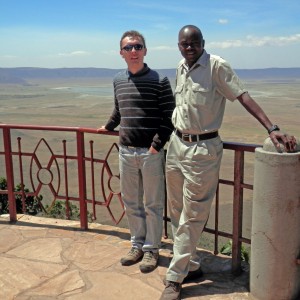 After travelling to Kenya’s Masai Mara in September and staying in the Serengeti in October, a visit to Lake Manyara and the Ngorongoro Highlands in Tanzania presented me with a new variety of experiences outside that of pure game viewing in the bush. In addition to good animal sightings, a trip to these areas also allows the visitor a chance to see rural Africa up close, while perhaps providing a slightly greater choice of accommodation options than are available in the Mara and Serengeti.
After travelling to Kenya’s Masai Mara in September and staying in the Serengeti in October, a visit to Lake Manyara and the Ngorongoro Highlands in Tanzania presented me with a new variety of experiences outside that of pure game viewing in the bush. In addition to good animal sightings, a trip to these areas also allows the visitor a chance to see rural Africa up close, while perhaps providing a slightly greater choice of accommodation options than are available in the Mara and Serengeti.
Half way through the unusually named, ‘Precision Air’ flight from Kenya to Tanzania, I looked out of my porthole on the left side of the aircraft and was dazzled by the sight of Africa’s most famous celebrity. Nelson Mandela had in fact not made a surprise appearance just off the port wingtip; instead I had just caught sight of another snow-topped icon of the continent: Kilimanjaro. The grey and white tip of the mountain protruded through the even blanket of cloud as we rattled quickly past en route to Kilimanjaro International Airport, leaving tourists just enough time to fumble around for cameras while the view slipped by to an unobtainable angle.
After landing, I drove west through Arusha towards Lake Manyara. I was surprised several times along the way, when the now familiar feeling of progressing over a rustic road surface was occasionally broken by sections of smooth Japanese sponsored tarmac. Driving through the centre of a provincial East African town was an interesting spectacle that I had not encountered previously on my travels. Arusha was busy. Traffic covered the streets, with motorcycle taxis, cyclists and tuk-tuks fearlessly joining the general throng of the central thoroughfare from side roads. Giving way is clearly an alien concept for Tanzanian drivers, and yet the flow of vehicles somehow managed to continue without any of the smaller craft coming to grief under the wheels of large, ancient lorries. The areas either side of the road were also alive with pedestrians, milling around visiting the colourful shops and ramshackle buildings that lined the street.
Leaving Arusha behind, we travelled westwards through rural countryside, passing villages and smallholdings interspersed with grazing land, small maize plantations and natural scrub. Hills broke the skyline and to the north I could just make out the hazy outline of the Rift Valley Escarpment that I was to ascend in a few days’ time.
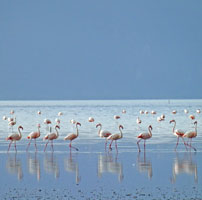 My first stop was on the shores of Lake Manyara. Here I arrived into an intensely tranquil scene. Long late afternoon shadows were forming on the reflective water, cast from the backs of flamingos as they gently treaded the glass-like surface. Resting a young, full-bodied South African (red) on my left knee, I sat back and prepared to enjoy an evening show that has been running even longer than Agatha Christie’s ‘Mousetrap’; it was time to watch the sun set. With the lake lapping at the shore, the great green mountainous backdrop of the Rift Valley escarpment faded gradually through shades of grey to black, as the incessantly unfolding spectacle of the sunset intensified, until the sun finally sank below the hillside in a ball of burning yellow.
My first stop was on the shores of Lake Manyara. Here I arrived into an intensely tranquil scene. Long late afternoon shadows were forming on the reflective water, cast from the backs of flamingos as they gently treaded the glass-like surface. Resting a young, full-bodied South African (red) on my left knee, I sat back and prepared to enjoy an evening show that has been running even longer than Agatha Christie’s ‘Mousetrap’; it was time to watch the sun set. With the lake lapping at the shore, the great green mountainous backdrop of the Rift Valley escarpment faded gradually through shades of grey to black, as the incessantly unfolding spectacle of the sunset intensified, until the sun finally sank below the hillside in a ball of burning yellow.
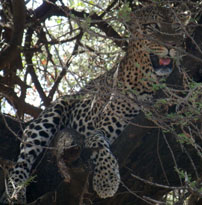 After a good night’s sleep I journeyed along the lake shore, seeing a variety of animals, including large troops of baboons and several herds of elephants, and although the park was picturesque, I felt that a half day visit was about right. We searched for the famous tree-climbing lions, and instead in a verge-side tree to the left of the road, I came across what I have now decided is my favourite of all the large cats; a leopard. This beautiful creature was lying in the shade, in the middle of the tree, panting in the mid-day heat as it settled down to a busy afternoon of digestion. I left the languid leopard, bade farewell to the flamingos and pressed on. Navigating through partially forested highlands, we passed the wattled huts of several Maasai villages before arriving at a camp near the rim of the Ngorongoro Crater, where I spent the night.
After a good night’s sleep I journeyed along the lake shore, seeing a variety of animals, including large troops of baboons and several herds of elephants, and although the park was picturesque, I felt that a half day visit was about right. We searched for the famous tree-climbing lions, and instead in a verge-side tree to the left of the road, I came across what I have now decided is my favourite of all the large cats; a leopard. This beautiful creature was lying in the shade, in the middle of the tree, panting in the mid-day heat as it settled down to a busy afternoon of digestion. I left the languid leopard, bade farewell to the flamingos and pressed on. Navigating through partially forested highlands, we passed the wattled huts of several Maasai villages before arriving at a camp near the rim of the Ngorongoro Crater, where I spent the night.
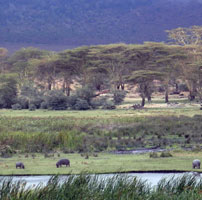 In the morning I was woken at 05h30 with a steaming cup of tea, ready for a bracing early start. The little tin teapot beside my bed shed a tear of condensation at our early parting, and I headed for the crater. The road was shrouded in a thick milky mist. Tiny villages were fleetingly visible as we whisked by, and glimpsing huts through the fog in the early morning light made it feel like I was entering into a world that had remained unchanged for centuries. My first view of the crater itself was truly breath-taking. Dazzling white rays from the sun were piercing the thick cloud that had been cloaking the landscape, and the full enormity of the crater was revealed. So vast is this caldera (formed when an ancient volcano collapsed) that there are several distinct areas of habitat inside the rim, and even a sizeable lake, which was marked out stunningly by the blinding sun.
In the morning I was woken at 05h30 with a steaming cup of tea, ready for a bracing early start. The little tin teapot beside my bed shed a tear of condensation at our early parting, and I headed for the crater. The road was shrouded in a thick milky mist. Tiny villages were fleetingly visible as we whisked by, and glimpsing huts through the fog in the early morning light made it feel like I was entering into a world that had remained unchanged for centuries. My first view of the crater itself was truly breath-taking. Dazzling white rays from the sun were piercing the thick cloud that had been cloaking the landscape, and the full enormity of the crater was revealed. So vast is this caldera (formed when an ancient volcano collapsed) that there are several distinct areas of habitat inside the rim, and even a sizeable lake, which was marked out stunningly by the blinding sun.
Negotiating the descent road into the crater was all part of the drama of entering into this unique world. As we bumped down the twisting track, we were heading into an incredible arena for viewing wild animals that had been closed off to the outside world by nature. The entertainment in this volcanic amphitheatre was first class, and the animal sightings were 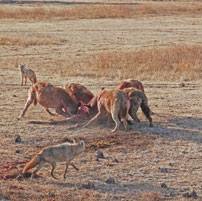 well and truly given a ‘thumbs up’. Right from the moment we entered the wide open grass plains on the crater floor, we came across a pack of hyaenas in a frenzy of activity. They devoured a wildebeest at record pace. Each animal quickly snatched food for themselves, while at the peripheries of the group, smaller golden jackals audaciously harassed their way in, snatching the occasional tit-bit with quick, effective raids into the fray. The impressive range of habitats that can be found in the crater soon became apparent as we drove on. In an area of swamp, we came across several hippos, some basking in lush green grass, others wallowing in leaden waters. A couple of adolescent males staged a miniature gladiatorial combat for my benefit, opening their mouths to an impossible gape and wrestling with their heads. I maintain that the altercation had been caused after the second hippo cast a wandering eye towards the wagtail on the back of the first hippo – a classic case of, ‘oi, are you looking at my bird?’…
well and truly given a ‘thumbs up’. Right from the moment we entered the wide open grass plains on the crater floor, we came across a pack of hyaenas in a frenzy of activity. They devoured a wildebeest at record pace. Each animal quickly snatched food for themselves, while at the peripheries of the group, smaller golden jackals audaciously harassed their way in, snatching the occasional tit-bit with quick, effective raids into the fray. The impressive range of habitats that can be found in the crater soon became apparent as we drove on. In an area of swamp, we came across several hippos, some basking in lush green grass, others wallowing in leaden waters. A couple of adolescent males staged a miniature gladiatorial combat for my benefit, opening their mouths to an impossible gape and wrestling with their heads. I maintain that the altercation had been caused after the second hippo cast a wandering eye towards the wagtail on the back of the first hippo – a classic case of, ‘oi, are you looking at my bird?’…
In addition to seeing an interesting array of birds, I also enjoyed watching a magnificent large male elephant nimbly destroying a bush using the combined tools of his dextrous trunk and enormous tusks. Plenty of big cats can also be seen here, and during my drive I saw a few lions with the aid of binoculars. The resident black rhinoceroses were similarly elusive, but I did catch a glimpse or two of them marching off into the distance.
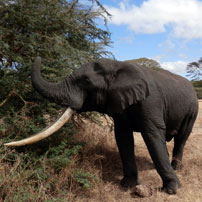 Relaxing around a blazing camp fire, with a captivating canopy of African constellations above my head and caressing a plucky little Burgundy, I was able to reflect properly on the unforgettable spectacles that I had been treated to after my early start. The incredible vistas and intense animal activity of the Ngorongoro Crater wonderfully complimented the quiet serenity of Lake Manyara and its graceful flamingos. Having enjoyed two months of adventure, exploring only a small fraction of the continent and already encountering a world of such contrasts, I’m left wondering what else might be out there.
Relaxing around a blazing camp fire, with a captivating canopy of African constellations above my head and caressing a plucky little Burgundy, I was able to reflect properly on the unforgettable spectacles that I had been treated to after my early start. The incredible vistas and intense animal activity of the Ngorongoro Crater wonderfully complimented the quiet serenity of Lake Manyara and its graceful flamingos. Having enjoyed two months of adventure, exploring only a small fraction of the continent and already encountering a world of such contrasts, I’m left wondering what else might be out there.
